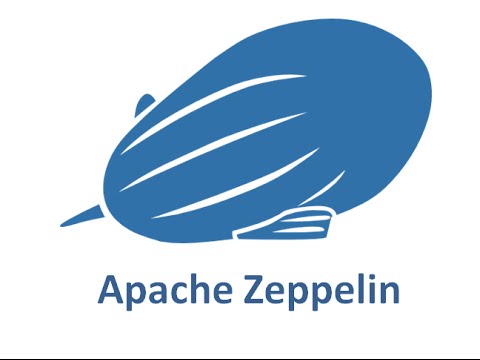How To Locally Install & Configure Apache Spark & Zeppelin

About
Apache Zeppelin is:
A web-based notebook that enables interactive data analytics. You can make beautiful data-driven, interactive and collaborative documents with SQL, Scala and more.
In this tutorial I am going to show you how to easily setup Apache Spark and Zeppelin locally. Specifically, I will show you step-by-step how to:
- Install Homebrew
- Install Spark & Its Dependencies
- Install Zeppelin
- Run Zeppelin
- Test Spark, PySpark, & Python Interpreters
- Setup Shiro Authentication
- Setup Zepl (formerly ZeppelinHub)
Assumptions
In order to keep this tutorial short, I am going to assume the following:
- You are familiar with bash
- You already have Xcode installed on your Mac (see App store)
- You run all commands from your home directory unless otherwise specified
- You already installed Anaconda w/Python < 3.6
Note: PySpark doesn’t play nicely w/Python 3.6; any other version will work fine.
Code that you should copy will look like this:
$ only copy text after the dollar sign
Install Homebrew
Homebrew is great because it will automatically take care of almost all the requisite setup for you. I found this to be the easiest install method.
- Copy and paste this command into Terminal:
$ /usr/bin/ruby -e "$(curl -fsSL https://raw.githubusercontent.com/Homebrew/install/master/install)"
Install Spark & Its Dependencies
- Copy and paste these commands into Terminal:
$ brew cask install java8 $ brew install scala $ brew install apache-spark
Install Zeppelin
- Copy and paste this command into Terminal:
$ brew install apache-zeppelin
Run Zeppelin
We need to start the Zeppelin daemon.
- Copy and paste this into Terminal:
$ zeppelin-daemon.sh start - Click this link or open any browswer and type:
http://localhost:8080Zeppelin should fire right up.
Test Spark, PySpark, & Python Interpreters
- In Zeppelin, click Create new note.
- A new window will open. Either keep the default Note Name or choose something you like. Leave spark as the Default Interpreter. Click Create Note.
- In the first box (called a paragraph), type sc.
- Press play button or hit Shift+Enter.
- This takes a few seconds so be patient. Everything is working properly if you get output that looks something like
res0: org.apache.spark.SparkContext = org.apache.spark.SparkContext@356639d8.
If you get an error, Spark is not configured properly. This should not happen if you used Homebrew.
- In a separate paragraph, type this:
%pyspark import numpy as np np.arange(10)If you get an error or a message that says PySpark is not responding, something is wrong with your configuration or metastore_db. Check the log files located in /usr/local/Cellar/apache-zeppelin/0.7.1/libexec/logs/.
Reminder: Python 3.6 will break PySpark. Use any version < 3.6.
- In yet another paragraph, type:
%python import numpy as np np.arange(8)No issues means everything is working properly. Feel free to test other modules at this time.
Setup Shiro Authentication
- In your Terminal window, navigate to /usr/local/Cellar/apache-zeppelin/0.7.1/libexec/conf.
- We need to copy three templates by copying and pasting these commands:
$ sudo cp shiro.ini.template shiro.ini $ sudo cp zeppelin-site.xml.template zeppelin-site.xml $ sudo cp zeppelin-env.sh.template zeppelin-env.sh - We need to change authentication from anonymous to username & password:
$ sudo nano shiro.ini - Scroll down to the [urls] section.
- Make sure it looks exactly like this:
#/api/version = anon /api/interpreter/** = authc, roles[admin] /api/configurations/** = authc, roles[admin] /api/credential/** = authc, roles[admin] #/** = anon /** = authc - Save changes and exit nano.
- Now that you are back in bash, type:
$ sudo nano zeppelin-site.xml - Locate zeppelin.anonymous.allowed.
- Set its value to false.
- Save changes and exit nano.
- Navigate to your home directory by typing:
$ cd - We need to restart Zeppelin so type:
$ zeppelin-daemon.sh restart - Go back to the Zeppelin notebook in your browser.
- A window should pop up asking for username and password.
- Use any of these username and password combos:
admin password1 user1 password2 user2 password3Note: usernames, passwords, and groups can be setup in shiro.ini file.
Setup Zepl (formerly ZeppelinHub)
- Go to Zepl
- Click blue Sign Up button.
- Supply Username, e-mail, password and click blue Create Account button
- Click New button towards top right of screen.
- Select Repository.
- Give it a name and description.
- Click blue Link button.
- A new window pops up with key information you’ll need to set environment variables.
- Let’s set those variables now. Type:
$ cd /usr/local/Cellar/apache-zeppelin/0.7.1/libexec/conf $ nano zeppelin-env.sh - Follow the instructions on Zepl for correctly updating zeppelin-env.sh. At the time of this writing, the updates looked like this:
export ZEPPELIN_NOTEBOOK_STORAGE="org.apache.zeppelin.notebook.repo.GitNotebookRepo, org.apache.zeppelin$ export ZEPPELINHUB_API_ADDRESS="https://www.zepl.com" export ZEPPELINHUB_API_TOKEN="INSERT YOUR TOKEN HERE" - Navigate to your home directory by typing:
$ cd - We need to restart Zeppelin again so type:
$ zeppelin-daemon.sh restart - You’ll notice that your Zepl repository is not connected to your local and does not have any of your notebooks loaded. Simply open each notebook, run some code, and then that notebook will load automatically.
- Congrats! You have installed and configured Apache Spark & Zeppelin on your local machine.
As always, I hope you found this tutorial helpful.
If you are new to Zeppelin and wondering “what can I do with it?”, stay tuned because I’m working on a Zeppelin tutorial that will showcase its many uses.
P.S. If you found any errors, I would love to hear about it.
